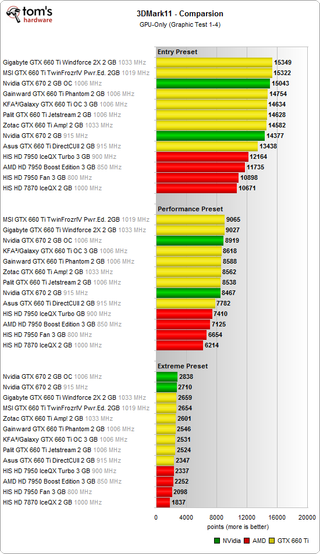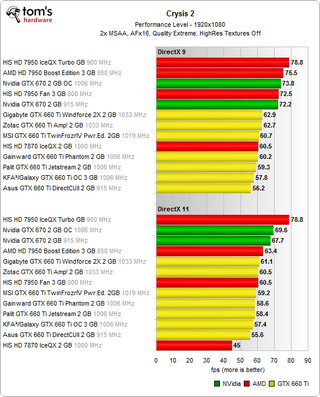Seven GeForce GTX 660 Ti Cards: Exploring Memory Bandwidth
Seven GeForce GTX 660 Tis landed in our lab. Today, we're benchmarking them, measuring their noise and temperatures, and conducting a more in-depth analysis of the impact a 192-bit memory interface has on performance. The results are enlightening!
Benchmark Results: 3D Performance
GeForce GTX 660 Ti Review: Nvidia's Trickle-Down Keplernomics included a ton of detailed performance benchmarks. Today, we're focusing on comparing the cards themselves. The largest differences between them are their factory GPU and memory overclocks. When it comes to quantifying the effects of those subtle changes, 3DMark 11 is pretty effective at normalizing variables and giving us good results.
Gigabyte's GeForce GTX 660 Ti Windforce 2X OC Edition at 1033 MHz and MSI's N660 Ti PE 2GD5/OC at 1019 MHz clearly pull ahead of their competition at 3DMark's Entry and Performance presets. But what about Zotac’s GeForce GTX 660 Ti AMP! Edition at 1033 MHz, the card with the highest memory clock rate? And why do the Palit and Gainward cards, which are almost identical, demonstrate different results?
The answer is both simple and surprising. But first, the benchmark:

The GPU Boost clock rates of the cards behave differently under load. The Asus and Zotac boards don’t increase at all. The Gainward card's GPU is apparently more scalable than Palit's, granting it somewhat better performance in spite of the almost identical technical specifications and build. This is interesting in light of the fact that Gainward is Palit’s flagship brand, and the Gainward GTX 660 Ti Phantom is more expensive than the Palit GTX 660 Ti Jetstream.
The Entry and Performance presets in 3DMark 11 aren't very memory bandwidth-dependent, but they do push each GPU to its limits. The following GPGPU-oriented benchmarks apply to 3DMark 11’s Extreme preset as well.

The two cards based on Nvidia's GeForce GTX 670 PCB clearly win under the synthetic's Extreme preset. This shows that a factory-overclocked GPU isn't everything; memory interface bandwidth matters as well.
This is a phenomenon we expected to see when Nvidia first announced GPU Boost, and we're starting to see it mess with the value of add-in board partner offerings. It makes less sense to pay more for a higher base clock when the effects of GPU Boost affect each piece of silicon differently (and there's nothing you can do about it).
Stay on the Cutting Edge
Join the experts who read Tom's Hardware for the inside track on enthusiast PC tech news — and have for over 25 years. We'll send breaking news and in-depth reviews of CPUs, GPUs, AI, maker hardware and more straight to your inbox.
DirectX 11 vs. DirectX 9 and Resolution
We benchmarked all seven cards using two game presets and two resolutions. Under DirectX 9, Gigabyte has the fastest GeForce GTX 660 Ti, followed closely by Zotac. On paper, this should have been the other way around, given Zotac's 100 MHz-higher memory clock rate. Our best guess is that the GPU on Zotac's card simply wasn't as good. Zotac does manage to outmaneuver the Gigabyte board under DirectX 11, though.
The other GeForce GTX 660 Tis perform on par with what we were expecting, based on their specs.


Although the GeForce GTX 670s behave as we'd expect, based on previous benchmarks, the GeForce GTX 660 Ti cards are slower under DirectX 9 than 11. Moreover, the clock rates of the most aggressively overclocked 660 Tis weren't high enough to contend with the slowest GeForce GTX 670. Of course, this could be by Nvidia's design after watching GTX 670s overtake pricier 680s.
Current page: Benchmark Results: 3D Performance
Prev Page Zotac GeForce GTX 660 Ti AMP! Edition Next Page Testing For Memory Interface Limitations-
scotthulbs I'd Like to know which 2GB model 660ti you used in this comparison? I would like to see how if perhaps the Zotac memory overclock has much of an effect on performance. If you used the Zotac in this comparison that may very well be the reason it outperforms the 3GB Galaxy card? Maybe run this same test overclocking the memory, it seems as though the 660ti with its memory overclocked can nearly reach GTX670 Bandwidth. I'd like to see how much that helps overcome the narrow bus.Reply -
mayankleoboy1 The problem with wider memory interface is that it exponentially increases the chip's die-size. Hence, cost per wafer and power consumption will increase a lot.Reply
IMO both AMD and Nvidia should use the XDR2 memory in the next series of cards. That would give the same bandwidth at half the interface size. -
iknowhowtofixitThis review reinforces what I have been saying for weeks. The GTX 660Ti is overpriced at $300. Since you can easily find a HD7950 for $300 or less after rebates, it makes the 660TI irrelevant. To me, the 660Ti needs to be $60-$75 cheaper before it can achieve bang for the buck status.it is because of the 660ti that the 7950 prices dropped to $300 or less with MIR: so tell me how irrelevant they are now?Reply
-
ahrensy For the Batman Arkham City tests on the 670 and 660ti, was the PhysX setting set to Off, Low or High?Reply -
EzioAs Reply9537131 said:it is because of the 660ti that the 7950 prices dropped to $300 or less with MIR: so tell me how irrelevant they are now?
The 7950 has been our for months now compared to the 660ti and the price drop happens before the release of the 660ti. Nvidia should really have predicted that the 7950 prices should come down even more so it makes almost no sense that they release the 660ti at $300.
The 7870 performs just slightly slower compared to the 660ti but beats it once you crank up the AA really high and it costs $50 less. On the other hand the 7950 is overall faster than the 660ti and even surpass the the $60+ 670 once you crank the AA really high as well. For the 660ti to sell, Nvidia should really lower it to $260 imo.....or they could just rely on fanboys -
Reply9537133 said:The 7950 has been our for months now compared to the 660ti and the price drop happens before the release of the 660ti.
AMD cuts HD 7000 series price even furtherTuesday, 21 August 2012 08:57 (after the 660ti release)
AMD has already dropped the HD 7970 from US $479 to US $429, HD 7950 from US $399 to US $349 and the HD 7870 down from US $349 to US $299. The new price cut skips the HD 7970 graphics card but includes the HD 7950, HD 7870 as well as the 1 and 2GB versions of the HD 7850.
The most important is probably the price cut for the 3GB HD 7950 which battles it out with Nvidia's recently released GTX 660 Ti. The HD 7950 3GB is, according to the report, will receive a US $30 price cut placing it at US $320. The HD 7870 2GB graphics card got another US $50 price cut pushing it down to US $250 which probably makes it one of the most interesting mid-range graphics cards on the market.
cheers! :) -
FormatC Reply
PhysX was off, because it affects the overall performance. PhysX is dead - ok, not quite, but almost ;)9537132 said:For the Batman Arkham City tests on the 670 and 660ti, was the PhysX setting set to Off, Low or High?
-
EzioAs Reply9537134 said:AMD cuts HD 7000 series price even furtherTuesday, 21 August 2012 08:57 (after the 660ti release)
AMD has already dropped the HD 7970 from US $479 to US $429, HD 7950 from US $399 to US $349 and the HD 7870 down from US $349 to US $299. The new price cut skips the HD 7970 graphics card but includes the HD 7950, HD 7870 as well as the 1 and 2GB versions of the HD 7850.
The most important is probably the price cut for the 3GB HD 7950 which battles it out with Nvidia's recently released GTX 660 Ti. The HD 7950 3GB is, according to the report, will receive a US $30 price cut placing it at US $320. The HD 7870 2GB graphics card got another US $50 price cut pushing it down to US $250 which probably makes it one of the most interesting mid-range graphics cards on the market.
cheers! :)
If you check the price of the 7950s before this news at most online retailer (Newegg, NCIX), you'll know that the price drop happens already although the official news from AMD was a couple of weeks later -
Reply
now you are talking complete nonsense unless you do not understand there were two price drops and the latter of which is because of the 660ti; as the article stated.so you want to see pricing history . . :)9537136 said:If you check the price of the 7950s before this news at most online retailer (Newegg, NCIX), you'll know that the price drop happens already although the official news from AMD was a couple of weeks later
Sapphire Radeon HD 7950 3GB Video Card
now how much sense does it make to drop prices and not tell anyone?
:pfff:
Most Popular

